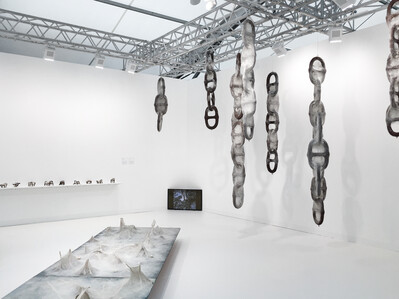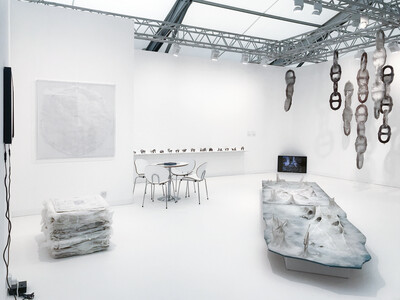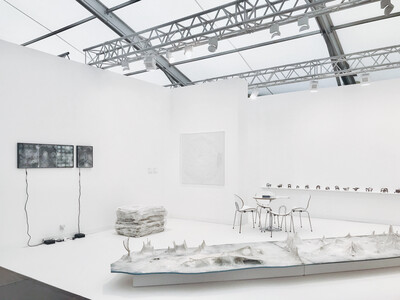个展 艺术博览会 伦敦,英国
[展位号 A13]
Liang Shaoji is one of the most unique and singular figures in the contemporary art scene in China. For 28 years, he has been working with his unusual partners - silkworms. Dubbed as a hermit residing in Tiantai (four-hour driving distance from Shanghai), Liang Shaoji patiently and purely devotes to art by his idiosyncratic creations imbued with ecological aesthetics. He discovers some kind of critical point where science and nature, biology and bio-ecology, weaving and sculpture, installation and performance could meet.
"When Liang Shaoji said “I am a silkworm,” he could not have used a simpler, more concise statement to summarise his decades of artistic pursuit and his ideals about art and artists. In one sense, “I am a silkworm” personifies and identifies with the Tang-dynasty poet Li Shangyin’s (813–858) famous verse: “Till the end of life do silkworms keep spinning silk.” In another sense, “I am a silkworm” is a visual development of Heidegger’s philosophical statement that poetry is a kind of homecoming. Liang has used Heidegger’s phrase, expressing his quest in the Nature Series as “looking up toward ‘poetry.’” Regardless of the specific theme of his work, whether cosmic philosophy or international politics, it is indeed poetry, written by the artist and nature together." - Wu Hung
Silkworm, silkworms’ world and Nature Series
Silkworm means more than just an animal to Chinese people. It is an integral part of Chinese civilisation. Liang Shaoji started to breed silkworms in 1989. He observed and studied how silkworms respond to grease, dirt, smooth and cold surface of metal and glass. These are mostly products of modern industrialisation. It is in fact the changes and difficulties brought about by the industrialised society we are looking at. Since then, Liang Shaoji has started his lifelong experiment and art creation Nature Series.
"In the process of creating the Nature Series, I regarded the breathing with silkworms as seeking an eye into the universe; an experiment which combined the godly and the human as well as recognition of science, history and society. The famous ancient Daoist, Zhuangzi once said "there is no high or low between things" (On the Equality of All Things). Reading the world of silkworms is just like interpreting the kingdom of humanity. To treasure all things means to cherish ourselves. When the fruit of art creation cannot explain the author's object and wisdom, process and conception will take its place. In the Nature Series, the rolling life nirvana of the silkworms opened up a boundless space." - Liang Shaoji
Mankind, nature, life
"Some say that the ultimate goal of art is for the artist to express their life experiences and emotions. Then what we see here is the life of a silkworm…… We can imagine the struggle, pain, and sublimation of a life in transformation that makes up the emotional and philosophical underpinnings of Liang’s work." - Wu Hung
It takes much patience and persistence to discover how inspirational the metamorphosis process of silkworms is. Liang Shaoji sees his studio as a modern laboratory where he “takes his works into a new space beyond conventional sites of art production” and scientific experiments. It is more like “an interface between art and science, between biology and bio-sociology, between various forms of art expressions and the cosmos itself.” What intrigues Liang Shaoji most is the symbolic meaning contained in silkworms and silk threads. Soft as it is, the thread silkworms produce, a symbol of history, warmth, generosity, and endurance of life, is very resilient and hard to be broken.
"By extending the exploration of natural elements through merging them with human bodies, an important part of his work, he provides us with radical experiences of the conditions of our existence in the contemporary world which is full of contradictions – the hegemony of the powerful, whether natural, human or social, is always being challenged and defeated by the weaker and more fragile but ever-changing forces, just like life itself." - Hou Hanru
"It's a realisation of the state of life. I think that all of our histories go back to the fundamental starting point of life according to the philosophy of Laozi, “there is always a movement from non-being to being and being to non-being”. The process of silkworms weaving is just like a cycle. The most important thing is life itself. Of course, there will be different historical changes during the process, but it will always return to the origin of life." - Liang Shaoji
Philosophy
Liang Shaoji’s works “have been turned into the embodiment of the ontological significance of life. It is about true meaning of living in the world.” Tiantai, where Liang has lived for nearly three decades, is the home of one sect of Buddhism and Taoism in China. This sacred ground proves to be an ideal place for reflection and meditation. Inspired by Taoist and Buddhist thinking, Liang has developed his encompassing philosophy of the equality of all living things, and the necessity of a bio-ecological approach to modern life. Liang Shaoji uses the life circle of silkworms as a
medium to reflect the traces of fleeting time, to imply the adventures of life and to illustrate the idea of “rebirth”. Many possibilities lying Chinese traditional culture and philosophy that remained to be explored from a contemporary perspective. Liang Shaoji is not entirely a recluse. Instead, he travels around the world, even when he’s in his seventies. He visits many of the major art exhibitions, where his works are often showed: Cloud Above Cloud, Museum of China Academy of Art, Hangzhou (2016); What About the Art? Contemporary Art from China, Al Riwaq, Doha, Qatar (2016); Liang Shaoji: Back to Origin, ShanghART Gallery, Shanghai (2014); Liang Shaoji: Questioning Heaven, Gao Magee Art Gallery, Madrid, Spain (2012); Art of Change, Hayward Gallery, London (2012); Liang Shaoji, Prince Claus Fund, Amsterdam (2009); Liang Shaoji: An Infinitely Fine Line, Zendai MOMA, Shanghai (2009); Liang Shaoji: Cloud, ShanghART H-Space, Shanghai (2007); The 5th Biennale d'Art Contemporain de Lyon, Lyon (2005); The 6th International Istanbul Biennial, Istanbul (1999); The 48th International Art Exhibition Venice Biennale, Venice (1999); China/Avant-Garde Art Exhibition, National Art Museum of China, Beijing (1989) etc. He was awarded the Chinese Contemporary Art Awards (CCAA) in 2002 and the Prince Claus Awards in 2009.
More Pictures:








